
Every year we’re guaranteed to see a selection of blockbuster titles that are equal parts well designed, technically competent and expertly produced. They are not always the most surprising games, but you enjoy them none the less because they’re so well made. Now imagine the opposite of this and you have NieR: Automata director Yoko Taro’s style of games. Taro is the kind of director who worries less about whether his games are “good” and more about whether they’re challenging conventions or trying to do something different. The original NieR is incredible because it pushed boundaries with its groundbreaking story and genre-bending ideas (not to mention an incredible soundtrack), but it’s also ugly as hell, very clunky, and has some seriously rubbish components. It’s no surprise it didn’t sell well, and it’s certainly not the sort of game I ever imagined a room filled with corporate suits could agree deserved a sequel.
Funnily enough, as it turns out, that’s kind of what happened. Action genre juggernaut PlatinumGames approached Square Enix a few years back to discuss a potential collaboration, and what better director to pair them with on a project than Yoko Taro – a man whose games are often brilliant but fall short because they’re mechanically mediocre. That’s not to imply PlatinumGames are faultless. Sure, they’ve crafted some of the best action games of our time, but the writing in their games is drivel, for lack of a better word, and let’s not forget about all of those rubbish licensed games either. Combining these two creative forces is possibly one of the best things to happen to either party, and by bringing in character artist Akihiko Yoshida (Final Fantasy XII/XIV, Bravely Default) to add some style, and Keiichi Okabe to deliver another phenomenal soundtrack, the result is the first legitimately excellent game in the Drakengard series.

Set on a post-apocalyptic Earth in the year 11945, NieR: Automata puts players in the smoking hot high heels of YoRHa android 2B – who, along with her companion 9S, is currently engaged in the 14th Machine War. The basic gist of the plot is that aliens invaded Earth several thousand years ago and, using an army of “living machines,” forced humanity to abandon the planet and take refuge on the moon to avoid extinction. Exiled and defeated, the surviving humans founded “Project YoRHa” as a means to try and reclaim their home, but this effort has mostly just consisted of sending a never-ending stream of specially configured androids down to Earth to fight in a proxy war against an equally met never-ending stream of alien-made machines. You’d think after the first thousand years of deadlock they would have tried doing something different, but clearly no one ever taught the YoRHa soldiers the definition of insanity.
In saying that, though; taking anything created by Yoko Taro at face value is about the equivalent of trusting Hideo Kojima to plan your birthday party. Every time the man puts pen to paper, the result is a story filled with multi-tiered messaging, constant misdirection and A LOT of underlining tragedy. Like with his previous games, you’re going to have to play through Automata several times to get the full picture, but this design choice has been handled well by allowing you to experience events from alternate perspectives (with all your progress and equipment carrying across), so it’s nowhere near as daunting as it might sound. It’s also important to note that while having played the original NieR will provide a greater context on certain historical events, this game is so far removed in the timeline that it will not hinder your ability to fully appreciate the story if you haven’t. Everything essential is naturally explained as you play.
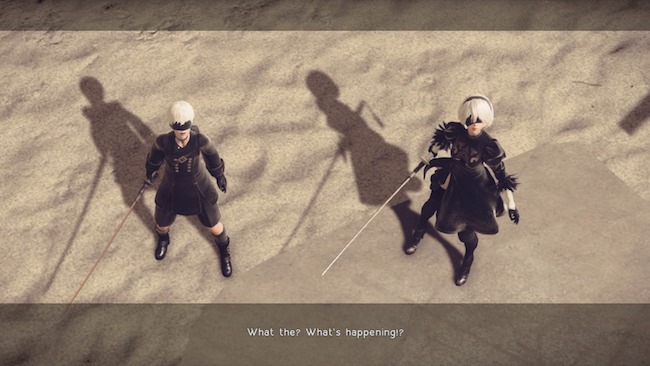
From the very get-go, Automata doesn’t waste any time in breaking away from conventions, opening as a bullet hell shooter that then seamlessly interchanges between a third-person hack-and-slash and side-scrolling platformer. It’s a weird and compelling blend of genres, although not entirely unexpected if you’ve ever played a Drakengard game before – well, with the exception that this one was built by a competent developer, so it doesn’t play like garbage. At its core, Automata could be described as an open-world action RPG, but there are a lot of unique ideas at play under the hood. Mechanically, the game utilises a fresh take on Platinum’s renowned combat system – which has for the first time been adapted to suit a much more flexible style of play. As most enemies are encountered out in the open, the fighting plays out very differently to something like Bayonetta or Metal Gear Rising – though it’s just as slick and stylish.
Possibly the best thing about the game’s design is how clean and elegant it is – which is a huge breath of fresh air by comparison to many open world games today. Levelling up is as simple as earning XP from combat, you find/buy weapons and then upgrade them to make them stronger, and you can also augment your character with plugin-in chips for stat boosts and special abilities – kind of like a digital take on Materia from Final Fantasy VII. The menus themselves are sleek and easy to navigate, with quests, items, weapons and skills all managed in an intuitive manner. There’s also an insightful intel section that tracks everything narratively significant, which is utterly joyful to dig into as there is SO MUCH context to everything. Taro loves to play on the fact the protagonist is an android and uses every opportunity he can to incorporate the game’s systems into that fantasy. There isn’t even a fourth wall to try and break.
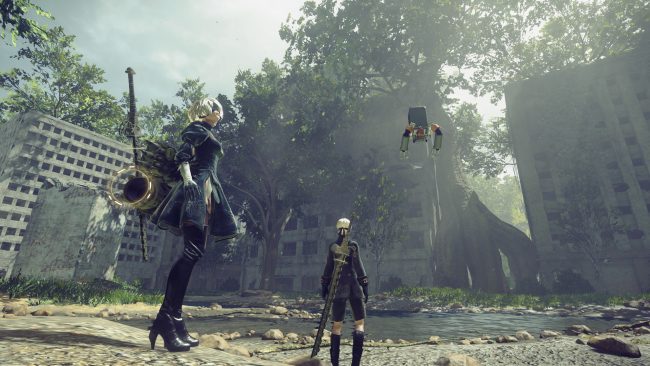
Automata primary takes place on Earth, though you will make an occasional trip into orbit to see YoRHa Command at “The Bunker.” The world itself is open with a variety of interconnected environments that range from lush forests to desert ruins. There is even an abandoned amusement park. Being in a post-apocalyptic condition, however, means that it’s largely devoid of life. You could say it’s empty, but there’s a sort of a cathartic sense of beauty about it, too. This doesn’t mean to imply there isn’t anything to do, though. There are a plethora of side quests you can undertake, as well as secrets to uncover, and exploration feels great because of how empowering the core mechanics are. Moves such as dashing, double jumping and gliding are all very effective in getting to hard to reach places. You can expect to encounter groups of machines often as you move through the environments, but it’s designed to not be too disruptive.
One issue I do have with the game’s design is the difficulty balancing. On normal, I personally found the combat just a touch too easy. It’s not that it isn’t enjoyable, more that it doesn’t push you just that little bit further to make a good weapon loadout and plugin-in configuration feel essential. Now, this might not be the case for everyone, and you may be asking why I didn’t just play it on hard? Good question! Hard mode is A LOT harder. The game by default not only requires manual saving, it employs a Soulslike system where, if you die, you drop your XP and plug-in chips. Die twice, and they’re gone. On hard, when you get insta-killed (which happens too easily) and have to reload a save (assuming you saved), it sucks, and not in a “gotta git gud” kind of way. This system does give back by allowing you to pick up temporary buffs or an ally from other player corpses, but it doesn’t really help. If you want to have fun, stick to normal.
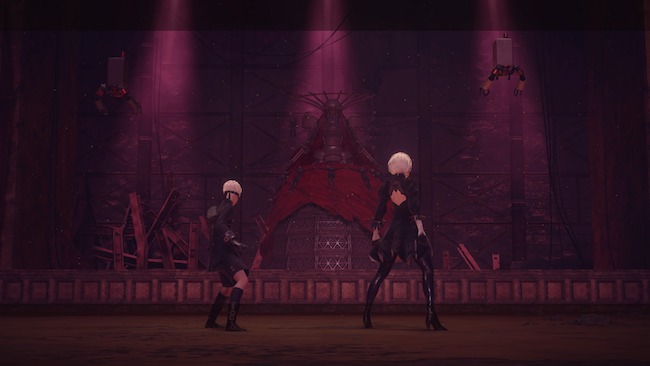
The story of the original NieR worked so well because of its unique, ragtag cast of characters, and while Automata doesn’t try to pull off the same trick twice, it succeeds on a different front. 2B is a combat model – cold by nature and by the books in how she approaches everything. 9S, on the other hand, is a scanner model who questions everything and is much more liberal in his beliefs. It’s a natural chemistry that works well without any strong romantic overtones to force the relationship. It also helps that the voice actors portraying the duo do a fantastic job. In combat, 2B and 9S play relatively the same but with one big exception. 2B can utilise two weapons at once, whereas 9S only carries one but has the ability to hack enemies. This plays out as a top-down puzzle shooter mini-game, which is both quick and satisfying. You can only play as 9S on your second playthrough, but the hacking works well to keep things interesting.
If you’re coming into this as more of a Platinum fan whose hungry for intense action and big set piece moments, you won’t walk away disappointed. While there’s certainly a lot more breathing room by comparison to their previous work, you can still expect things to get intense with epic boss battles that’ll satisfy your lust for destruction. Each android also comes equipped with a “Pod” which can fire continuously as you chip away with your sword (as well as activate special abilities such as a laser beam or shield). If you’re here as a Yoko Taro fan, however, you’re in for a treat. There are a lot of callbacks to both Drakengard 3 and the original NieR for you to try and piece together, as well a cameo from a certain beloved character that ties into an optional quest which is bound to stir up emotions in some fans. As one such fan, there was a particular piece of music from the original NieR I was hoping to hear, and I wasn’t let down.
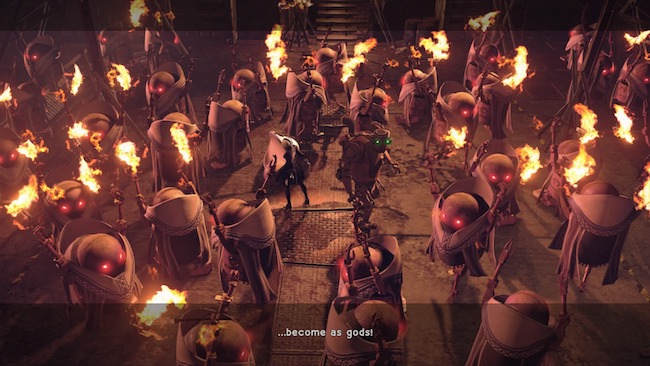
Just like with its predecessor, Keiichi Okabe has delivered yet another phenomenal soundtrack for Automata. I’d even go as far as to say it’s one of the best of any game I’ve played – and no, I’m not exaggerating. The music plays such a critical role in crafting a captivating and emotionally fuelled experience from beginning to end. From sombre tones to powerful orchestral pieces, and everything in-between, the soundtrack uses a mix of lyrics from an invented language as well as snippets of machine dialogue to great effect. While the overarching story might be centred around androids fighting against machines in the future, it’s also very clearly holding up a mirror to the human race and using science fiction as a means to explore the human condition. How far you want to dig is really up to you, as the surface-level plot is weird and excellent on its own, but to say this game has had a profound effect on me would be an understatement.
The quest design ranges from unique and enjoyable to cookie-cutter time waster. It’s very much a typical JRPG affair – though, on that front, I’m glad I didn’t have to sift through the life story of every NPC to get the information I needed. What sets it apart, and what compelled me to keep playing, however, is the quality of the writing. While the activities themselves may not always be the most stimulating, the individual stories cover a broad range of compelling subjects often pertaining to human culture and ideology. As a result, exploring the open world and completing quests is often a thought-provoking experience. Apart from your companion sometimes getting in the way and frame pacing/graphical pop-in issues while out in the larger environments, there is very little to hinder your adventure. Although, I am curious why moose and giant boars are the only surviving mammals remaining on Earth… But hey, you can ride them at least!
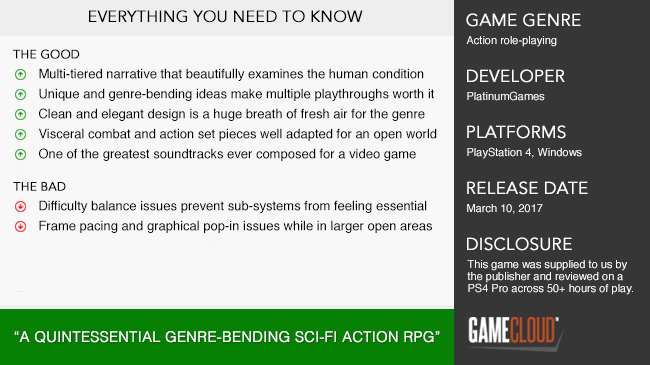
I can’t tell you how good it feels to recommend a Yoko Taro game without first apologising for all of the shortcomings you must work through to appreciate its brilliance. By combining his out there ideas with a developer who knows how to make phenomenal action games under the right direction, the result is a genre-bending RPG that doesn’t make any compromises. Whether you’re a fan of Platinum’s visceral combat and insane action set pieces or the unusual ideas and thought provoking narratives of the Drakengard series, you will not be disappointed with NieR: Automata. While I personally took issue with the difficulty balancing, and yes, the performance does suffer from a few technical hiccups while out in larger open areas, it’s still genuinely one of the most engrossing games I’ve ever played. It’s well designed, technically competent and expertly produced – exactly like a blockbuster game, except that it’s unique and surprising.











